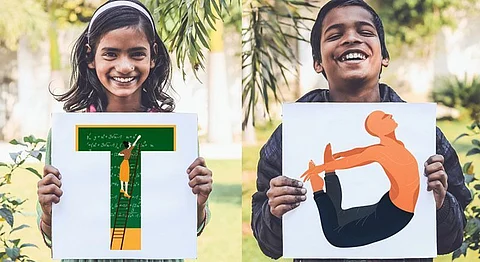
- HOMEGROWN WORLD
- #HGCREATORS
- #HGEXPLORE
- #HGVOICES
- #HGSHOP
- CAREERS
- ABOUT US
- CONTACT US

One thing that social media has been good for is serving as a platform for the exploration and recognition of incredible art. Instagram challenges, in particular, have become exceptional showcases of innovation, talent and creative genius, and one that really piques our interest is 36 Days of Type. To put it simply, the challenge is for artists – or anyone really – to design new typography and letters for the 26 alphabets and 10 numbers, in creative ways of their choosing.
Some have used it as a medium to showcase their unique artistic sensibilities - from combining art and music and constellations to drawing out the A-Z of Mughal History - while some just had fun with their creativity. Artist Devika Pillai, a NIFT graduate, chose to utilise the platform in a way that is not only visually creative but also gives a voice to underprivileged children’s hopes and dreams. She enlisted help from Donate An Hour, an NGO that believes in the value of giving your time and energy to the children as opposed to just monetary donations – an ideology that encourages them to speak up and share their thoughts, ultimately leading to better communication and a high level of understanding. With the objective of highlighting their hope for a bright future, and with the aim of finding people who will help, she met with and spoke to the kids, listened to them describe what they want their future to look like, what they want to be when they grew up and then skilfully translated it into wonderful illustrations that represent a myriad of aspirations - from A for Artist to Z for Zoologist.
Speaking to Homegrown, Devika shares her journey, and how it all took shape.
HG: How did you interpret 36 Days of Type?
DP: “While the project is primarily about pushing your craft every day for 36 days, an idea for a larger theme which wasn’t centred just around a well-designed alphabet was a starting point. Considering the wide visibility that the project receives every year, I wanted to use the platform to highlight a bigger cause and a broader message.”
HG: Tell us more about your background as a designer.
DP: “I graduated from NIFT after pursuing Fashion Communication where Graphic Design was my one of my core subjects. While at the time I would’ve liked the course to more on GD, I do think the variety of subjects gave us a broader perspective on the different skill sets working together in the industry. I started freelancing while in college with UX and Infographics for advertising before working with Branding and Identity at Codesign, Delhi. I’ve now moved back into freelancing with a focus on building some side projects that explore broader ideas and help me push myself as a designer.”
HG: You used the Instagram challenge as a platform to raise awareness. What inspired you to do so?
DP: “We spend most of our time today on social media platforms. For a lot of us, it also inspires, educates and makes the world a smaller place. ’36 days of type’ on Instagram is a great example of user-generated content that promises a global reach and engagement making it an ideal platform to say something bigger.”
HG: What would you want the main takeaway to be from this project?
DP: “The hope was to remind people that dreams and aspirations are not limited to children born into privilege and to help them view these children as one amongst us untainted by the way society perceives and categorizes them. From a more design-centric perspective, I was happy I could tie together a larger cause with my skill set and hope more designers were inspired to do so.”
HG: How did you go about the entire process?
DP: “We first interacted with about 45-50 children at one their centres over 2 days - getting them to think about what they wanted to be and what excited them. It was great to see how uninhibited and thoughtful they were in their responses. As ideal as it would’ve been, there were letters with which no occupations were mentioned and some instances where a lot of them wanted to be, say a ‘Soldier’. Filtering these out and not having certain letters in the series was a restricting yet expected setback. However considering the nature of the series, the primary objective shifted from making sure I had 36 designed forms, to keep the project as original as possible.”
HG: What role did the NGO ‘Donate An Hour’ play in the project?
DP: “I spoke to a couple of NGOs initially but what stood out with ‘Donate an Hour’ was their firm belief and insight that uplifting the morale and exposure of underprivileged children through an hour of interaction was of bigger value than donations. They were also quick to point out how most of India is not looking for monetary help but self-reliance at a larger scale where education undoubtedly champions the cause. It was great to work with a team that was as excited about the project as I was. I was also fortunate to have a great friend in a photographer (Gorkey Patwal) with whom I collaborated to execute the idea behind the series.”
You can view more from the entire and her entire series on Behance. All photographs taken by Gorkey Patwal.
If you liked this article we suggest you read:
